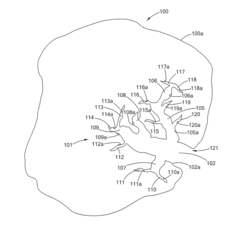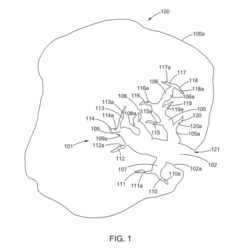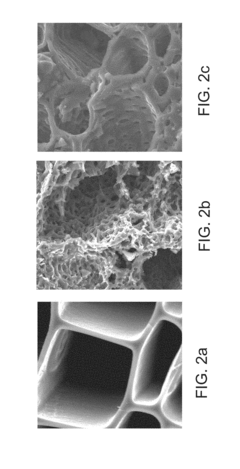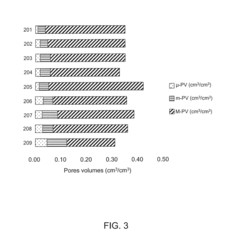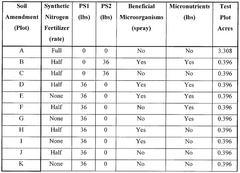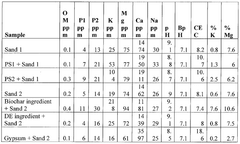Investigating Biochar Additives in Polypropylene for Soil Enrichment
Biochar-PP Composite Background and Objectives
Biochar, a carbon-rich material produced through the pyrolysis of biomass, has gained significant attention in recent years for its potential to enhance soil fertility and sequester carbon. Concurrently, polypropylene (PP) has established itself as a versatile and widely used thermoplastic polymer in various industries. The convergence of these two materials in the form of biochar-polypropylene composites represents a novel approach to addressing soil enrichment challenges while potentially mitigating plastic waste issues.
The development of biochar-PP composites stems from the growing need for sustainable agricultural practices and the increasing concern over plastic pollution. By incorporating biochar into polypropylene, researchers aim to create a multifunctional material that can serve both as a soil amendment and a degradable plastic alternative. This innovative approach aligns with global efforts to promote circular economy principles and reduce the environmental impact of conventional plastics.
The primary objective of investigating biochar additives in polypropylene for soil enrichment is to harness the beneficial properties of biochar while leveraging the structural integrity and processability of polypropylene. Biochar's high surface area, porosity, and ability to retain nutrients make it an excellent candidate for improving soil quality. When combined with polypropylene, these properties could potentially be preserved and gradually released into the soil as the composite degrades.
Furthermore, this research aims to explore the possibility of creating a controlled-release mechanism for nutrients and beneficial soil microorganisms. By fine-tuning the composition and structure of biochar-PP composites, it may be possible to develop materials that slowly decompose in soil, providing a sustained source of nutrients and organic matter over an extended period.
Another crucial aspect of this investigation is to assess the environmental impact and degradation behavior of biochar-PP composites in various soil conditions. Understanding how these materials break down and interact with soil ecosystems is essential for ensuring their safety and efficacy as soil amendments. This includes evaluating potential risks associated with microplastic formation and any unintended consequences on soil biota.
The technological evolution in this field is driven by advancements in materials science, polymer chemistry, and agricultural technology. Researchers are exploring various biochar feedstocks, production methods, and polymer blending techniques to optimize the performance of biochar-PP composites. This interdisciplinary approach combines expertise from diverse fields, including soil science, polymer engineering, and environmental studies.
As the global community continues to seek sustainable solutions for agriculture and waste management, the development of biochar-PP composites represents a promising avenue for innovation. By addressing both soil health and plastic pollution concerns, this research has the potential to contribute significantly to sustainable agricultural practices and circular economy initiatives.
Market Analysis for Soil Enrichment Solutions
The soil enrichment solutions market has been experiencing significant growth in recent years, driven by increasing global demand for sustainable agricultural practices and improved crop yields. This market encompasses a wide range of products and technologies designed to enhance soil fertility, structure, and overall health. Key segments within this market include organic fertilizers, biochar, soil conditioners, and microbial inoculants.
The global soil enrichment solutions market was valued at approximately $5.3 billion in 2020 and is projected to reach $8.5 billion by 2026, growing at a CAGR of 8.2% during the forecast period. This growth is primarily attributed to the rising adoption of precision farming techniques, increasing awareness of soil degradation issues, and the shift towards organic farming practices.
Regionally, North America and Europe currently dominate the soil enrichment solutions market, accounting for over 60% of the global market share. However, Asia-Pacific is expected to witness the highest growth rate in the coming years, driven by rapid agricultural modernization in countries like China and India.
The biochar segment, which is particularly relevant to the investigation of biochar additives in polypropylene, is experiencing robust growth within the soil enrichment solutions market. The global biochar market size was valued at $1.5 billion in 2020 and is projected to reach $3.1 billion by 2025, growing at a CAGR of 13.2% during the forecast period.
Key drivers for the biochar market include its ability to improve soil fertility, increase crop yields, and sequester carbon. The integration of biochar with polypropylene for soil enrichment represents an innovative approach that could potentially address multiple market needs, including soil health improvement and plastic waste management.
Consumer trends indicate a growing preference for environmentally friendly and sustainable agricultural solutions. This trend aligns well with the concept of biochar-infused polypropylene products for soil enrichment, as it combines waste reduction with soil improvement capabilities.
However, challenges in the soil enrichment solutions market include the high initial costs of some advanced solutions, lack of awareness among small-scale farmers, and regulatory hurdles in certain regions. For biochar-based solutions, additional challenges may include ensuring consistent quality and developing standardized application methods.
In conclusion, the market analysis reveals a growing demand for innovative soil enrichment solutions, with biochar-based products showing particular promise. The investigation of biochar additives in polypropylene for soil enrichment aligns well with current market trends and could potentially address multiple market needs, positioning it as a promising area for further research and development.
Current Challenges in Biochar-Polymer Integration
The integration of biochar additives into polypropylene for soil enrichment applications faces several significant challenges. One of the primary obstacles is achieving uniform dispersion of biochar particles within the polymer matrix. Biochar, being a highly porous and hydrophilic material, tends to agglomerate when mixed with hydrophobic polypropylene. This agglomeration can lead to inconsistent material properties and reduced overall performance of the composite.
Another major challenge lies in maintaining the structural integrity of the polypropylene matrix while incorporating sufficient amounts of biochar to provide meaningful soil enrichment benefits. Higher biochar loadings, while potentially more beneficial for soil applications, can compromise the mechanical properties of the polymer, leading to reduced tensile strength, elongation at break, and impact resistance. Striking the right balance between biochar content and polymer performance is crucial for developing viable products.
The thermal stability of the biochar-polypropylene composite during processing and application presents another hurdle. Biochar typically has a lower thermal degradation temperature compared to polypropylene, which can result in char formation and degradation of the composite during high-temperature processing or when exposed to elevated temperatures in soil applications. This thermal mismatch necessitates careful consideration of processing conditions and potential modifications to improve the thermal stability of the composite.
Compatibility between biochar and polypropylene at the interface level is also a significant challenge. The poor interfacial adhesion between the hydrophilic biochar and hydrophobic polypropylene can lead to weak bonding, resulting in reduced mechanical properties and potential leaching of biochar particles from the polymer matrix when exposed to soil conditions. Developing effective compatibilization strategies or surface treatments for biochar is essential to enhance the interfacial interaction and overall composite performance.
Furthermore, the variability in biochar properties, depending on feedstock and production conditions, poses challenges in achieving consistent and reproducible composite materials. Differences in particle size distribution, surface chemistry, and porosity of biochar can significantly impact the final properties of the biochar-polypropylene composite, making it difficult to standardize production processes and ensure uniform product quality.
Lastly, the long-term stability and degradation behavior of biochar-polypropylene composites in soil environments remain poorly understood. Balancing the desired slow release of biochar components for soil enrichment with the need to prevent microplastic pollution from degrading polypropylene is a complex challenge that requires extensive research and careful material design.
Existing Biochar-PP Composite Formulations
01 Biochar-polypropylene composites for soil enrichment
Composites of biochar and polypropylene are developed for soil enrichment applications. These composites combine the benefits of biochar's soil-improving properties with polypropylene's durability and ease of processing. The resulting material can be used to enhance soil structure, water retention, and nutrient availability while providing a slow-release mechanism for the biochar.- Biochar-polypropylene composites for soil enrichment: Composites of biochar and polypropylene are developed for soil enrichment applications. These composites combine the benefits of biochar's soil-improving properties with polypropylene's durability and ease of processing. The resulting material can be used to enhance soil quality, improve water retention, and promote plant growth while maintaining structural integrity.
- Slow-release nutrient delivery systems: Biochar-polypropylene composites are engineered to act as slow-release nutrient delivery systems for soil enrichment. The porous structure of biochar is utilized to store and gradually release nutrients, while the polypropylene matrix provides controlled degradation. This approach ensures a sustained supply of nutrients to plants over an extended period.
- Enhanced water retention and soil structure improvement: Biochar additives in polypropylene composites are designed to improve soil structure and water retention capabilities. The high surface area and porosity of biochar, combined with the structural properties of polypropylene, create a material that can effectively retain moisture and improve soil aeration, leading to better plant growth conditions.
- Biodegradable biochar-polypropylene blends: Development of biodegradable biochar-polypropylene blends for soil enrichment applications. These materials are designed to break down over time, releasing biochar into the soil while minimizing plastic pollution. The controlled degradation of the polypropylene matrix allows for the gradual integration of biochar into the soil ecosystem.
- Functionalized biochar-polypropylene composites: Biochar and polypropylene composites are functionalized with additional components to enhance their soil enrichment properties. This may include the incorporation of beneficial microorganisms, specific nutrients, or other soil-improving additives. The functionalized composites offer tailored solutions for various soil types and agricultural needs.
02 Production methods for biochar-polypropylene additives
Various methods are developed to produce biochar-polypropylene additives for soil enrichment. These methods may include melt blending, extrusion, or other polymer processing techniques to incorporate biochar into polypropylene matrices. The production processes are optimized to ensure uniform distribution of biochar and maintain the beneficial properties of both components.Expand Specific Solutions03 Controlled release mechanisms for biochar in soil
Innovative designs are implemented to control the release of biochar from polypropylene matrices into the soil. These mechanisms may involve surface treatments, porosity control, or the use of degradable polymer blends to gradually expose the biochar to soil microorganisms and plant roots over time, maximizing its effectiveness in soil enrichment.Expand Specific Solutions04 Enhanced soil properties through biochar-polypropylene additives
The addition of biochar-polypropylene composites to soil results in improved soil properties. These improvements may include increased water retention, enhanced nutrient availability, improved soil structure, and increased microbial activity. The polypropylene component helps to stabilize the biochar in the soil, prolonging its beneficial effects.Expand Specific Solutions05 Environmental impact and sustainability of biochar-polypropylene soil additives
Research focuses on the environmental impact and sustainability of using biochar-polypropylene composites as soil additives. Studies examine the long-term effects on soil health, potential for carbon sequestration, and the lifecycle analysis of these materials. Efforts are made to optimize the balance between the benefits of soil enrichment and the environmental considerations of using polymer-based additives.Expand Specific Solutions
Key Players in Biochar-Polymer Composites
The biochar additives in polypropylene for soil enrichment market is in an early growth stage, with increasing research and development activities. The market size is relatively small but expanding, driven by growing interest in sustainable agriculture and soil improvement technologies. The technology is still evolving, with varying levels of maturity among key players. Companies like Cool Planet Energy Systems and Carbon Technology Holdings are at the forefront, developing innovative biochar-based solutions. Academic institutions such as Shenyang Agricultural University and Southwest Forestry University are contributing to fundamental research. Collaboration between industry and academia is accelerating technological advancements, while companies like Poet Research and Ordos Dongsheng District Environmental Management are exploring practical applications and scaling up production.
Cool Planet Energy Systems, Inc.
Eidgenössische Materialprüfungs & Forschungsanstalt Empa
Innovative Biochar-PP Binding Mechanisms
- Infusing biochar with beneficial additives such as nutrients, microbes, and enzymes to create a porous structure that allows for gradual and prolonged release, enhancing soil retention and plant growth, and using treatment processes like vacuum impregnation and surfactant treatment to improve biochar's water retention and microbial viability.
- A soil additive composed of diatomaceous earth, calcium sulfate, and biochar is formulated to reduce the need for synthetic nitrogen fertilizers and pesticides, promoting healthier soil and crop growth.
Environmental Impact Assessment
The environmental impact assessment of incorporating biochar additives into polypropylene for soil enrichment is a critical aspect of evaluating the sustainability and ecological consequences of this innovative approach. Biochar, a carbon-rich material produced through pyrolysis of organic matter, has gained attention for its potential to improve soil quality and sequester carbon. When combined with polypropylene, a widely used plastic, it creates a unique composite material that may offer both agricultural and environmental benefits.
One of the primary environmental advantages of this technology is its potential to reduce plastic waste in agricultural settings. Polypropylene is commonly used in various agricultural applications, such as mulch films and packaging. By incorporating biochar into polypropylene, the resulting material may degrade more readily in soil environments, reducing long-term plastic accumulation. This could significantly mitigate the environmental burden associated with conventional plastic use in agriculture.
The carbon sequestration potential of biochar-polypropylene composites is another crucial environmental consideration. Biochar is known for its ability to store carbon for extended periods, potentially mitigating greenhouse gas emissions. When integrated into polypropylene and applied to soil, this composite material may enhance the carbon storage capacity of agricultural lands, contributing to climate change mitigation efforts.
Soil health improvement is a key environmental benefit of this technology. Biochar has been shown to enhance soil fertility, water retention, and microbial activity. By gradually releasing biochar into the soil as the polypropylene matrix degrades, these composites could provide sustained soil enrichment benefits. This may lead to reduced fertilizer use, decreased water consumption, and improved overall soil ecosystem health.
However, potential environmental risks must also be carefully assessed. The degradation of polypropylene in soil may release microplastics, which could have adverse effects on soil organisms and potentially enter the food chain. Additionally, the production process of biochar-polypropylene composites should be evaluated for its energy consumption and emissions to ensure a net positive environmental impact.
The long-term effects on soil microbial communities and nutrient cycling must be thoroughly investigated. While biochar generally promotes microbial activity, its interaction with polypropylene may alter these effects. Comprehensive studies are needed to understand how these composites influence soil biodiversity and ecosystem functions over extended periods.
In conclusion, the environmental impact assessment of biochar additives in polypropylene for soil enrichment reveals a complex interplay of potential benefits and risks. While the technology shows promise in addressing plastic waste, enhancing carbon sequestration, and improving soil health, careful consideration must be given to potential drawbacks such as microplastic generation and long-term ecosystem effects. Continued research and rigorous environmental monitoring will be essential to fully understand and optimize the ecological implications of this innovative approach.
Regulatory Framework for Soil Additives
The regulatory framework for soil additives plays a crucial role in ensuring the safety and efficacy of products like biochar-infused polypropylene for soil enrichment. In the United States, the Environmental Protection Agency (EPA) oversees the regulation of soil additives under the Federal Insecticide, Fungicide, and Rodenticide Act (FIFRA). This act requires manufacturers to register their products and provide extensive data on their composition, intended use, and potential environmental impacts.
For biochar additives in polypropylene, the regulatory process involves demonstrating that the product does not pose unreasonable risks to human health or the environment. This includes providing toxicological data, environmental fate studies, and efficacy tests. The EPA also considers the potential for bioaccumulation and persistence in soil ecosystems.
In the European Union, soil additives are regulated under the European Fertiliser Regulation (EU) 2019/1009. This regulation sets out harmonized rules for the marketing of EU fertilizing products, including soil improvers like biochar-infused materials. Manufacturers must comply with specific requirements for nutrient content, contaminant limits, and labeling.
The regulatory landscape also extends to international standards, such as those set by the International Organization for Standardization (ISO). ISO 17225-8:2022, for instance, provides specifications for graded biochar, which could be relevant to the development of biochar-polypropylene composites for soil enrichment.
Compliance with these regulations often requires extensive testing and documentation. For biochar additives in polypropylene, this may include leaching studies to assess the release of potential contaminants, biodegradation tests to evaluate the material's persistence in soil, and field trials to demonstrate efficacy in improving soil quality.
Manufacturers must also consider regional variations in regulatory requirements. Some countries may have additional restrictions or specific guidelines for novel soil additives. For example, Australia's Department of Agriculture, Water and the Environment has specific regulations for biochar products under their biosecurity laws.
As the field of soil additives continues to evolve, regulatory frameworks are likely to adapt. Ongoing research into the long-term effects of biochar and polymer composites on soil ecosystems may inform future regulatory decisions. Manufacturers and researchers must stay abreast of these developments to ensure continued compliance and product safety.
